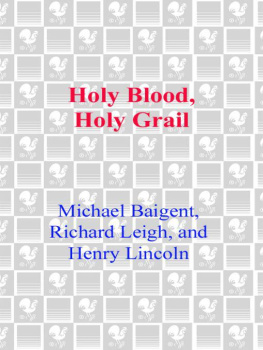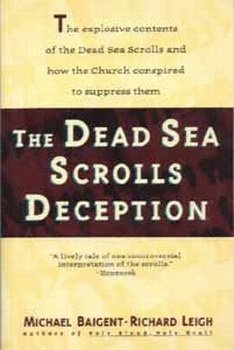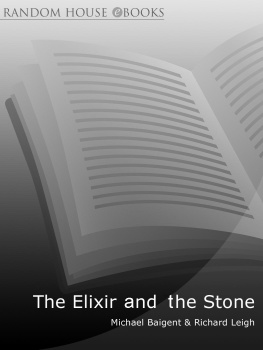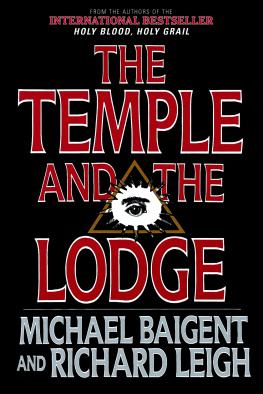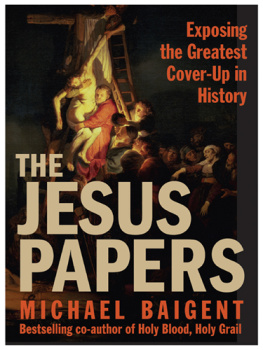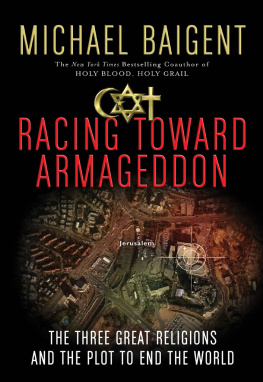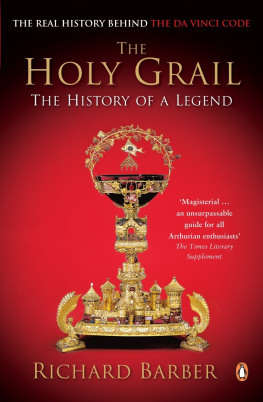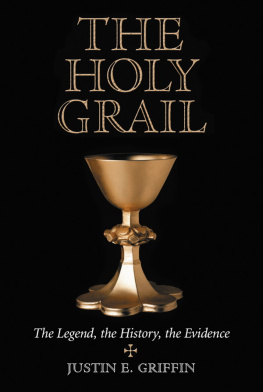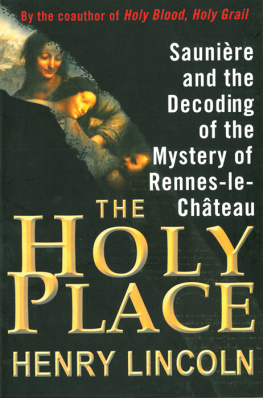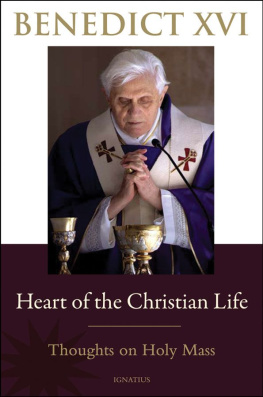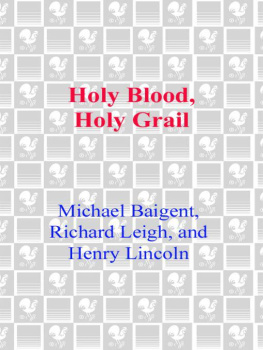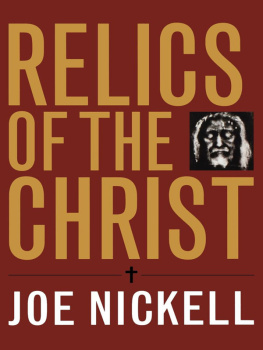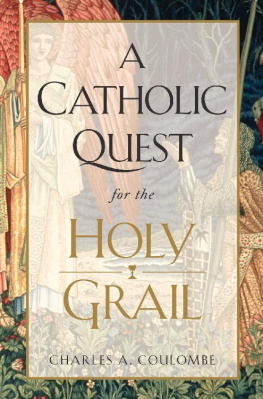Table of Contents
DID JESUS MARRY AND FATHER A CHILD? ARE HIS DESCENDANTS ALIVE TODAY?
PRAISE FOR
HOLY BLOOD, HOLY GRAIL
"To call Holy Blood, Holy Grail controversial would be
an understatement. The books contentions have met a
religious firestorm." International Herald Tribune
"If you like a pleasant brainteaser from the What If
school of historical speculation you will be sure to enjoy
this book."
Los Angeles Herald Examiner
"A highly provocative work of investigative journalism."
Booklist
"A bizarre theory." Houston Chronicle
"A thoroughly concept-shattering web of historical intrigue.... Destined to become an occult classic."
Fate Magazine
"Revolutionary and provocative.... Whether taken as
incontrovertible proof, or simply fascinating
documentation of a theory, Holy Blood, Holy Grail
will intrigue all readers."
Baker and Taylor Book Alert
BY THE SAME AUTHORS
THE MESSIANIC LEGACY
Acknowledgments
We should like particularly to thank Ann Evans, without whom this book could not have been written. We should also like to thank the following: Jehan lAscuiz, Robert Beer, Ean Begg, Dave Bennett, Colin Bloy, Juliet Burke, Henri Buthion, Jean-Luc Chaumeil, Philippe de Chrisey, Jonathan Clowes, Shirley Collins, Chris Cornford, Painton Cowan, Roy Davies, Liz Flower, Janice Glaholm, John Glover, Liz Greene, Margaret Hill, Renee Hinchley, Judy Holland, Paul Johnstone, Patrick Lichfield, Douglas Lockhart, Guy Level, Jane McGillivray, Andrew Maxwell-Hyslop, Pam Morris, Les Olbinson, Pierre Plantard de Saint-Clair, Bob Roberts, David Rolfe, John Saul, Grard de Sde, Rosalie Siegel, John Sinclair, Jeanne Thomason, Louis Vazart, Colin Waldeck, Anthony Wall, Andy Whitaker, the staff of the British Museum Reading Room and the residents of Rennes-le-Chteau.
Photographs were kindly supplied by the following: AGRACI, Paris, 36; Archives Nationales, Paris, 16a; Michael Baigent, London, 1,2,5, 6, 7, 14, 15, 18, 24, 25, 31, 32, 34; Bibliothque Nationale, Paris, 28, 29, 30; Michel Bouffard, Carcassonne, 4; W. Braun, Jerusalem, 11, 13; British Library, London, 9, 16b, 35; British Museum, London (reproduced by courtesy of the Trustees of the British Museum), 33; Courtauld Institute of Art, London, 10; Roy Davies, London, 26, 27; Devonshire Collection, Chatsworth (reproduced by permission of the Trustees of the Chatsworth Settlement), 21; Jean Dieuzaide/YAN photo, Toulouse, 8; Galleria Nazionale dArte Antica, Rome, 20; Patrick Lichfield, London, 23; Henry Lincoln, London, 3; Muse du Louvre, Paris, 22; Ost. Nationalbibliothek, Vienna, 19; H. Roger Viollet, Paris, 12, 17.
Permission to quote extracts in copyright was granted by: Le Charivari magazine, Paris for material from issue no. 18, "Les Archives du Prieur de Sion"; Victor Gollancz, London and Harper & Row, Publishers, Inc., New York for specified material on pp. 280-82 from pp. 14-17 in The Secret Gospel by Morton Smith copyright 1973 by Morton Smith; Random House, Inc., New York for material from Parzival by Wolfram von Eschenbach, translated by Helen Mustard and Charles E. Passage, copyright 1961 by Helen Mustard and Charles Passage.
Le jour du mi-t tranquille
Brle au centre de lestoile,
O miroite la mare dedans
Son cur dor Nymphaea montre clair.
Nostres dames adores
Dans lheure fleurie
Dissoudent les ombres tnbreuses du temps.
JEHAN LASCUIZ
Introduction to the Paperback Edition
On January 18, 1982 The Holy Blood and the Holy Grail was published in England. Five weeks later, on February 26, it appeared in the United States. During the month attending publication in each country we found ourselves amid what seemed at times a kind of circus. We had written a book which we knew would be controversial in certain respects. We expected it to be criticized in the usual waysin book reviews by the vested theological and historical interests we had implicitly challengedbut we expected no more attention than most publications usually receive. To our bemused bewilderment, however, we found ourselves attracting as much celebrity (or, more accurately, notoriety) as if wed personally staged a coup detat in the Vatican. Not only did we attract reviews, we also attained certifiable shock-horror status as a news storya full-fledged news story that actually made the front pages of various newspapers. It was, granted, a quiet time: things were relatively calm in Poland; no public figures had been shot of late; and Argentina had not yet invaded the Falklands. In the absence of anything more catastrophic we became darlings of the media. Responses and reactions assumed torrential proportions, pouring in to the newspapers, our publishers and agent, and ourselves. The spectrum of responses was so broad that it seemed entirely different books were being referred to. At one extreme there were reactions epitomized by a letter which extolled our book as "the greatest work of the century"a judgment which we unfortunately cannot presume to share. At the opposite extreme there were statements which, albeit less succinctly, implied it might well be the worst. Rarely in recent publishing history have so many Don Quixotes tilted so zealously against one small windmill.
Much of the furor was precipitated by the BBCs Omnibus, on which Barry Norman interviewed us along with Hugh Montefiore, bishop of Birmingham, and the historian Marina Warner. Somewhat naively, with a lamb-being-led-to-slaughter acquiescence, we had accepted an invitation to appear on the program. The producer had earnestly assured us that we would be participating in a discussion that would permit some serious exploration of our books conclusions. We had no way of knowing at the time that our producers definition of discussion was somewhat idiosyncratic. By our own definition we seemed to have blundered not into a discussion, but into an ambush staged by some latter-day ad hoc Inquisition. After Barry Norman had summarized something which bore only a tenuous resemblance to our book, Ms. Warner and the bishop proceeded to adumbrate, pell-mell, a prearranged scroll of charges long enough to sanction an immediate auto-da-f of both our work and ourselves. To shift metaphors, we found ourselves suddenly subjected to a blitz. Broad generalities and pedantic trivialities were launched against us like a veritable Luftwaffe of flies. We could have swatted virtually all of them; we did, in fact, swat a great many. But it takes only a moment for a voice, arrogating the resonance of authority, to stigmatize a bookto label it irresponsible, implausible, poorly researched, or simply bad. It takes rather longer to refute such charges. One must do so point by point, citing specific examples. One must become embroiled in minutiae and academic quibbles that scarcely conduce to good television, for good television revels more in dramatic bloodbaths than in dry exchanges of information. For every half-dozen objections raised by Ms. Warner and the bishop, we were allowed to reply to only one in studio; and when the program was transmitted on January 17th, even many of the replies allowed us had been excised. Each of us was edited down to one or two statutory comments, and that was all. In consequence the "discussion" seen by BBC viewers was very different from the "discussion" that actually occurred in the studio. A number of people commented afterward that it seemed wed not been given much chance to speak. In reality we were given slightly more chance than was apparent, but most of what we said ended up on the cutting-room floor.
Such things constantly happen in the world of televisiona world with which we were sufficiently familiar not to have been surprised. The pity of it was that some magnificently comic moments were irretrievably lost. For example, at one point Barry Norman asked the bishop whether such books as ours were potentially dangerous. "Absolutely," replied the bishop, who had only read two chapters of it. Our book, he declared, was a shameless exploitation of sex and sensationalism. A stunned silence descended on the studio. Sex? Had we written a book about sex? We gaped at one another in stupefaction, half-wondering whether a deranged printer had bound a few pages of the Kama Sutra into our text or replaced one of our illustrations with a picture of a nude Templar. As far as we knew, our book, on a scale of sexiness, ranked somewhere below the Turin shroud, which, though a full frontal portrait of a naked man, has never attracted much prurient interest.

